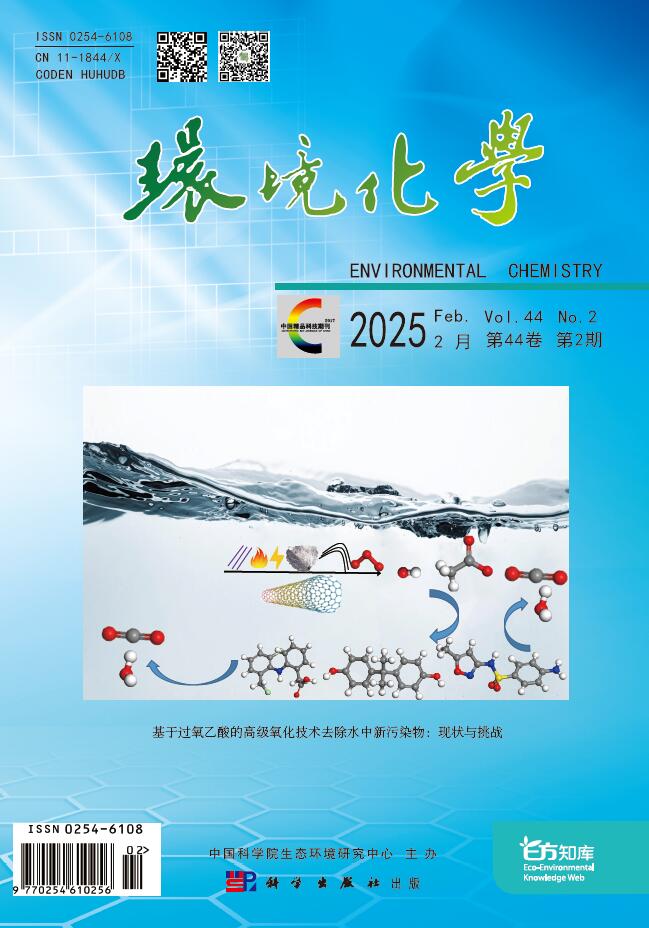|
[1]
|
DARBRE P D. The history of endocrine-disrupting chemicals[J]. Current Opinion in Endocrine and Metabolic Research, 2019,7:26-33.
Google Scholar
Pub Med
|
|
[2]
|
MURRAY A, RMECI B and P.C.LAI E, et al. Use of sub-micron sized resin particles for removal of endocrine disrupting compounds and pharmaceuticals from water and wastewater[J]. Journal of Environmental Sciences, 2017,51(1):256-264.
Google Scholar
Pub Med
|
|
[3]
|
华江环, 韩建, 郭勇勇, 等. 孕激素左炔诺孕酮长期低剂量暴露对雄性斑马鱼的生殖毒性[J]. 生态毒理学报, 2019,14(2):176-186.
HUA J H, HAN J, GUO Y Y, et al. Reproductive toxicity of the progesterone levonorgestrel to male zebrafish after long-term low dose exposure[J].Asian Journal of Ecotoxicology, 2019,14(2):176-186(in Chinese).
Google Scholar
Pub Med
|
|
[4]
|
HUANG Y, XIE X C, ZHOU L, et al. Multi-phase distribution and risk assessment of endocrine disrupting chemicals in the surface water of the Shaying River, -Huai River Basin, China[J]. Ecotoxicology and Environmental Safety, 2019,173:45-53.
Google Scholar
Pub Med
|
|
[5]
|
胡波,朱慧峰. 黄浦江上游水质评价因子的选择与评估[J]. 净水技术, 2016,35(3):54-57.
HU B, ZHU H F. Selection and evaluation of water quality assessment factors in the upper reaches of Huangpu River[J]. Water Purification Technology, 2016,35(3):54-57(in Chinese).
Google Scholar
Pub Med
|
|
[6]
|
李青松, 高乃云, 马晓雁, 等. 上海市原水及地表水中SEs调查及风险评估[J]. 中国给水排水, 2013,29(15):146-149.
LI Q S,GAO N Y,MA X Y, et al. Survey and risk assessment of SEs in raw water and surface water in Shanghai[J]. China Water Supply and Drainage, 2013,29(15):146-149(in Chinese).
Google Scholar
Pub Med
|
|
[7]
|
黄文平, 胡霞林,尹大强,等. 超高效液相色谱串联质谱同时快速检测环境水体中31种内分泌干扰物[J]. 环境化学, 2017,36(4):875-884.
HUANG W P,HU X L,YIN D Q, et al. Rapid and simultaneous determination of 31 endocrine disrupting chemicals in aquatic environment by ultra performance liquid chromatography-tandem mass spectrometry[J]. Environmental Chemistry, 2017,36(4):875-884(in Chinese).
Google Scholar
Pub Med
|
|
[8]
|
郑晓红. 近十年来黄浦江上游水源地水质状况及影响原因分析[J]. 仪器仪表与分析监测, 2006(4):42-46. ZHENG X H. Analysis of water quality status and influence causes of water sources in the upper reaches of Huangpu River in recent ten years[J]. Instrumentation and Analytical Monitoring, 2006
(4):42-46(in Chinese).
Google Scholar
Pub Med
|
|
[9]
|
CAREGHINI A, MASTORGIO A F, SAPONARO S, et al. Bisphenol A, nonylphenols, benzophenones, and benzotriazoles in soils, groundwater, surface water, sediments, and food:A review[J]. Environmental Science and Pollution Research, 2015,22(8):5711-5741.
Google Scholar
Pub Med
|
|
[10]
|
SALGUEIRO-GONZÁLEZ N, CAMPILLO J A, VIÑAS L, et al. Occurrence of selected endocrine disrupting compounds in Iberian coastal areas and assessment of the environmental risk[J]. Environmental Pollution (Barking, Essex:1987), 2019,249:767-775.
Google Scholar
Pub Med
|
|
[11]
|
PENGCHENG X, XIAN Z, DEFU X, et al. Contamination and risk assessment of estrogens in livestock manure:A case study in Jiangsu Province, China[J]. International Journal of Environmental Research and Public Health, 2018,15(1):125.
Google Scholar
Pub Med
|
|
[12]
|
LIU D, LIU J, GUO M, et al. Occurrence, distribution, and risk assessment of alkylphenols, bisphenol A, and tetrabromobisphenol A in surface water, suspended particulate matter, and sediment in Taihu Lake and its tributaries[J]. Marine Pollution Bulletin, 2016,112(1):142-150.
Google Scholar
Pub Med
|
|
[13]
|
XU W. Endocrine-disrupting chemicals in the Pearl River Delta and coastal environment:Sources, transfer, and implications[J]. Environmental Geochemistry and Health, 2014,36(6):1095-1104.
Google Scholar
Pub Med
|
|
[14]
|
LIU Y H, ZHANG S H, JI G X, et al. Occurrence, distribution and risk assessment of suspected endocrine-disrupting chemicals in surface water and suspended particulate matter of Yangtze River (Nanjing section)[J]. Ecotoxicology & Environmental Safety, 2017,135:90-97.
Google Scholar
Pub Med
|
|
[15]
|
DUAN X Y, LI Y X, LI X G, et al. Alkylphenols in surface sediments of the Yellow Sea and East China Sea inner shelf:Occurrence, distribution and fate[J]. Chemosphere, 2014,107:265-273.
Google Scholar
Pub Med
|
|
[16]
|
YAMAZAKI E, YAMASHITA N, TANIYASU S, et al. Bisphenol A and other bisphenol analogues including BPS and BPF in surface water samples from Japan, China, Korea and India[J]. Ecotoxicology & Environmental Safety, 2015,122:565-572.
Google Scholar
Pub Med
|
|
[17]
|
GORGA M, INSA S, PETROVIC M, et al. Occurrence and spatial distribution of EDCs and related compounds in waters and sediments of Iberian rivers[J]. Science of the Total Environment, 2015,s 503-504:69-86.
Google Scholar
Pub Med
|
|
[18]
|
PIGNOTTI E, FARR M, BARCEL D, et al. Occurrence and distribution of six selected endocrine disrupting compounds in surface-and groundwaters of the Romagna area (North Italy)[J]. Environmental Science and Pollution Research, 2017,24(26):21153-21167.
Google Scholar
Pub Med
|
|
[19]
|
JO O R M, CATARINA C, M RIO R, et al. Toxicological relevance of endocrine disruptors in the Tagus River estuary (Lisbon, Portugal)[J]. Environmental Monitoring and Assessment, 2015,187(8):483.
Google Scholar
Pub Med
|
|
[20]
|
LIU D, LIU J, GUO M, et al. Occurrence, distribution, and risk assessment of alkylphenols, bisphenol A, and tetrabromobisphenol A in surface water, suspended particulate matter, and sediment in Taihu Lake and its tributaries[J]. Marine Pollution Bulletin, 2016,112(1-2):142-150.
Google Scholar
Pub Med
|
|
[21]
|
HOPKINS K D, SHELTON W L and ENGLE C R. Estrogen sex-reversal of Tilapia aurea[J]. Aquaculture, 1979,18(3):263-268.
Google Scholar
Pub Med
|
|
[22]
|
WANG Y, WANG Q, HU L, et al. Occurrence of estrogens in water, sediment and biota and their ecological risk in Northern Taihu Lake in China[J]. Environmental Geochemistry and Health, 2015,37(1):147-156.
Google Scholar
Pub Med
|
|
[23]
|
NADERI M, WONG M Y,GHOLAMI F, et al. Developmental exposure of zebrafish (Danio rerio) to bisphenol-S impairs subsequent reproduction potential and hormonal balance in adults[J]. Aquatic Toxicology, 2014,148(2):195-203.
Google Scholar
Pub Med
|





 DownLoad:
DownLoad:
